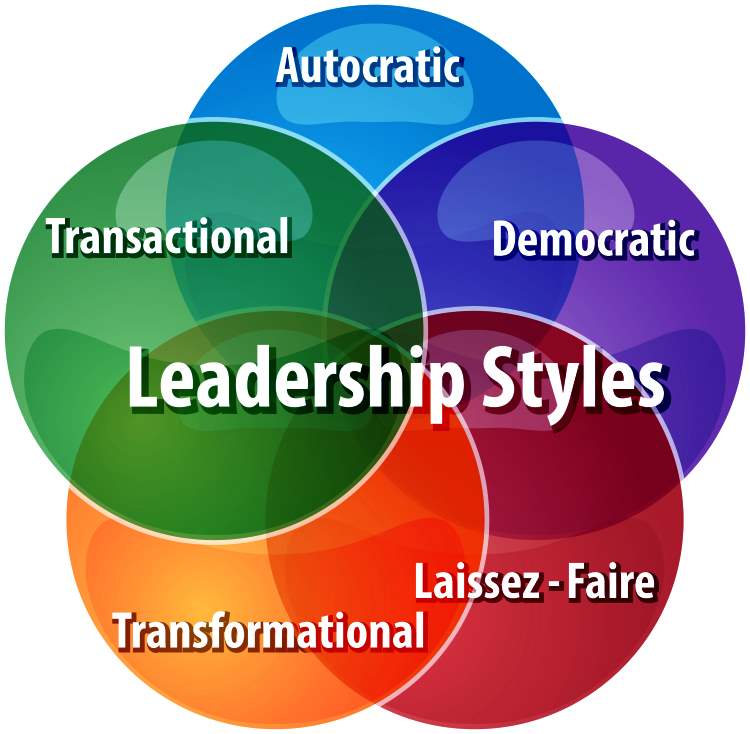Introduction
You have a manager and he has his style, then you have another manager with a completely different style. Confusing sometimes. In this article, I am going to help you distinguish between different types of leadership styles.
 Nowadays there are three main leadership styles: charismatic/transforming, democratic and autocratic, with each having sub-divisions. I am giving a short description of the characteristics of each style, discussing the advantages and disadvantages and indicating which one works best.
Nowadays there are three main leadership styles: charismatic/transforming, democratic and autocratic, with each having sub-divisions. I am giving a short description of the characteristics of each style, discussing the advantages and disadvantages and indicating which one works best.
Fed up with your leaders? In the end, I will give you my number one recommendation in case you want to become your own boss.
The charismatic/transforming styles
Lately, a great deal of attention was paid to the impact of the so-called transforming management styles. This showed that the following things are characteristic:
- Charisma or the behavior of leaders, where they have a warm atmosphere, convincing, take positions and appeal to employees on an emotional level.
- Inspiring motivation including through the publication of an inspiring vision, including values and team values.
- Intellectual stimulation, challenging beliefs and procedures.
- Individual consideration, listening to and meeting needs, coaching and mentoring.

Meaningful work
The importance of meaningful work and the focus on control of the employee i.e. how and when the work is done. According to a recent study, these styles correlate most with aspects such as employee satisfaction, motivation of the employees and assessed effectiveness of the leader.
I personally could not agree more. You would be lucky to encounter one of these two following styles.
Inspiring
This is the most ‘dominant’ of the charismatic styles. The leader who uses this style inspires and encourages others through his self-assured interaction style, courage and clear messages. Often this attitude is referred to in the literature as “managerial courage”. Typical key concepts are:
- communicating clearly about the vision
- if the situation requires them, giving clear instructions
- taking self-assured action, and daring to go against the flow if necessary
- deciding issues when performance or organizational problems pop up
- decisively lead people and conversations
Coaching
This is clearly the most preferred style by the employees because this style is  characterized by the attention paid to employees. A manager who uses this style invests time and energy in her/his employees. Typical key concepts are:
characterized by the attention paid to employees. A manager who uses this style invests time and energy in her/his employees. Typical key concepts are:
- involving the employees in the work and giving them the opportunity to take initiatives
- always having a listening ear
- making time for employees (talking about work, about their development)
- understanding and mediating in conflicts
The democratic styles
These styles are sometimes described as “management by exception – active”: the leader watches from a distance; he/she monitors performance and only takes (corrective) action if necessary. This is only possible if standards and rules have been set before.
In terms of satisfaction with managerial and employee satisfaction in general, one of these styles always scores well, especially the participatory style. Often this style gets the second-best score in this area after the coaching style.
Participative
This is the most appreciated of the democratic styles. For example, the manager who uses this style has an employee’s say in decisions or builds decisions together. Empowerment is often also mentioned as a characteristic  of this style: this means giving self-control and autonomy to the employees. Some see it as encouraging, sometimes compelling employees to take responsibility. This sense of responsibility must grow thanks to the application of this leadership style.
of this style: this means giving self-control and autonomy to the employees. Some see it as encouraging, sometimes compelling employees to take responsibility. This sense of responsibility must grow thanks to the application of this leadership style.
Typical key concepts for this style are:
- having modesty, calm and patience
- trusting employees
- asking questions and listening to the opinions of employees
- involving employees in decisions
- giving their staff room in the performance of their duties
Passive
Overall, it can be said that this concerns non-leadership or the avoidance of his/her responsibilities as a manager.
In scientific research, these styles are mostly referred to as “passive leadership”, “laissez-faire” or “management by exception – passive”. A manager will only intervene at the moment that the problems are already serious.
Withdrawn
This style is strongly characterized by personal and professional absence and  indecision. Employees will soon think that the manager has no ambition and a lack of interest. This style leads to demotivation and employees who feel lost.
indecision. Employees will soon think that the manager has no ambition and a lack of interest. This style leads to demotivation and employees who feel lost.
The following core concepts are part of this style:
- letting tensions and problems last too long
- leaving employees to their fate,
- not giving enough challenges
- giving too little time and guidance to his/her employees
Distrustful
The person who uses this style intervenes too late in the event of conflicts in the group or operational problems and is often suspicious of the motives of employees. The leader who uses this style hesitates and is unclear about what he/she wants and the direction to follow.
The following core concepts are part of this style:
- having unclear positions, withholding important information and hiding intentions
- assessing others quickly and mostly negatively
- being indecisive and anxious
The autocratic styles
Managers who use these styles mainly hope that they can enforce obedience (“compliance”) from their employees. If this happens occasionally, this is part of the “normal” behavioral repertoire, but if this happens frequently, this is problematic. Various studies into stress show that these styles result in a huge social cost, both for the companies themselves due to much workforce movements and high absenteeism, but also for society as a whole, due to the costs of health care for work-related sickness absence.
No understanding
Those who use this style communicate in a hard way, without showing much understanding for the other party. There are a lot of unilateral rules/requirements imposed and demanded.
Research
Recently research has been conducted into the effects of these leadership styles. It can be seen that reference is made to “destructive leadership” or “toxic leadership”, because these styles can result in dictatorial behavior, fraud, narcissism, exploitation, etc. I have described narcissistic bosses in this article.
Unfortunately, there are still many executives who hold the popular but scientifically incorrect belief that this style produces good results, especially in crisis situations. I would say that if you have this style long enough, you will end up in a crisis situation anyway.
Directive
A manager who uses this style often strives (in the eyes of others) to achieve personal success in a competitive manner. They monitor and correct their employees in an active way and often refer to standards and rules. The following core concepts are part of this style:
- striving to achieve her/his objective
- being very result-oriented
- working on their own careers; focused on (personal) success
- wanting obedience / having high demands
Authoritarian
 People answering questionnaires will almost without exception say they detest this style. They perform things in a one-sided and unpleasant way. There is anger in all kinds of gradations, like irritation, annoyance, impatience. The following core concepts are part of this style:
People answering questionnaires will almost without exception say they detest this style. They perform things in a one-sided and unpleasant way. There is anger in all kinds of gradations, like irritation, annoyance, impatience. The following core concepts are part of this style:
- domination and dictation
- no tolerance for any responses
- threatening with sanctions
- being unexpectedly cool and hard
- often expressing annoyance and anger
I would call this management style decisively: management by fear. Not far off of modern slavery, ok, but without the whips.
Final thoughts + Recommendation
I personally prefer the coaching, inspiring or participative styles of leadership and I wish anybody would have this kind of management. Unfortunately, I see the rest as, maybe not bad for the company, but certainly not very good or even bad for the employee. I would not flourish under passive, distrustful and withdrawn leadership.
If you happen to be under autocratic style leadership, you better take immediate action in order to avoid complete de-motivation, stress and even health problems. Modern slavery is present, but should not be tolerated at all. It can destroy people’s life.
Try something new!
If you are interested in becoming your own boss, away from the corporate jungle, then there is a way out. Join the best internet business support group in the world: Wealthy Affiliate (WA). Have a website in minutes, find your passions and have your product niche, scam-free, reasonably priced and build your own business. And start making earnest money! See my full review of WA here.
Which type of boss do you have or did you get rid of? Let us know by filling in the comment box.


Hi Jerry! Thank you for your inspiration.
When I drove my transport company, it was vitalfor me to have people who could act and think on their own.
My way of doing that was to give my crew co-determination. I put their day together. With some of the staff. Well, I had the last word.
But mostly allowed them to find out how the task was to be solved. I firmly believe that giving people insights into everyday life. They also grow with the job. It is my foundation in leadership.
May I ask you which form you think is the best, to get the most out of your crew?
Steen
Thanks Steen, you can be my boss anytime! With your management style, people will have a chance to improve on themselves. They will feel that when the company grows, they will also. Better motivation you cannot have. I have worked best under coaching or participative leadership. I do not need somebody to look over my shoulder all the time. As a manager myself, I tried to challenge and involve my team as much as possible, did not tolerate a sweet mouth, complimented and corrected where necessary, without giving preference to anybody. As soon as they understand this, you will get the best out of them.